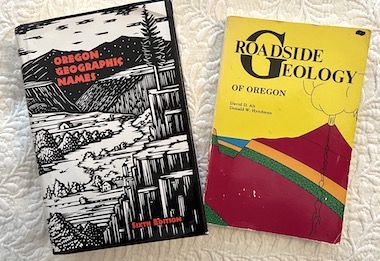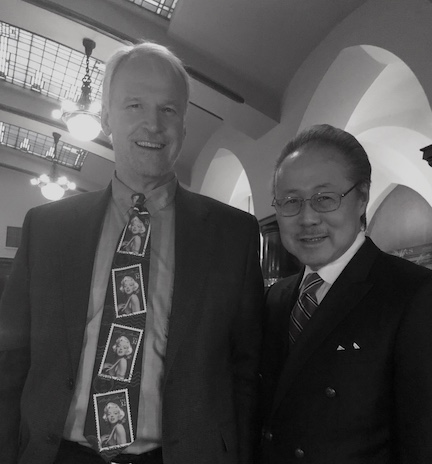Travel Oregon the right way? If you live here you know the drill:
Fill up the gas tank, or unplug the battery, and head for the big north to south roads.
Take in the coast on Hwy 101.
Head out on I-5 for the Willamette Valley sights.
Or aim your ride over the the mountains and make the run on Hwy 97.
All three will make if from Washington to California and back.
Travel Oregon is what happens in between, but you’ll miss so much if you stay on the main roads.
If you don’t take Oregon Geographical Names and Roadside Geology of Oregon along you’ll miss even more.
An Oregon classic since 1928, Oregon Geographic Names is a comprehensive reference to place-names throughout the state. Generations of readers, from librarians and researchers to travelers and people interested in Oregon history, have used and enjoyed this fascinating and definitive resource.
A short aside about librarians and researchers: In our current day and age we are all librarians and researchers and archivists. How is this possible?
It’s your computer, smart phone, even TV. Saying “Hey Siri,” or calling on Alexa is all the proof needed. If we don’t know something, we ask.
What about being archivists? Yes, my readers, we are all archivists. There’s a few ways of confirming this.
Look in a coat closet. Are there coats from the past you can’t bring yourself to donate? How about shoes? Do you have special occasion shoes? Still not convinced?
Look in your garage, junk drawers, or storage unit. You are either an archivist or a hoarder.
Your choice.
Travel Oregon The Smart Way
The seventh edition (of Oregon Geographical Names) is significantly expanded, with more than 6,200 entries reporting what is known about the origin and meaning of each name. An accompanying CD holds biographic and geographic indexes and maps that show the locations of over 1,600 post offices and nearly 1,300 communities and geographic features.
If, like me, you get annoyed looking at a map of the United States and the size discrepancy between eastern states, Northeastern in particular, and western states, one question comes up:
How did anyone decide to call Rhode Island, or Connecticut, or dinky Delaware a state? From this side of the continent the entire eastern seaboard looks sketchy.
East coast states along the Atlantic Ocean number 14.
West coast? Three.
Distance from Portland, Maine, to Miami, Florida? 1356 miles.
From Canadian border to Mexican border on the west coast? 1400 miles.
If you knew this, you are a bonafide researcher. Good job. If you didn’t know this, now you do.
Oregon Roadside Geology For Former Drop Out
This book stunned me during my last college science class before graduating with a U.S. History degree with an emphasis on Oregon History and a minor in Latin American History.
I was a non-traditional student, which is nice way of saying drop out.
Was I following the advice to turn on, tune in, and drop out? No Tim Leary for me. Besides, why would a PhD academic tell kids to drop out? After my first drop I joined the Army, the opposite of turning on and tuning in.
Instead of making up a story I could believe about the benefits of dropping out a few times, I dropped in and wrapped things up. At thirty-nine years old. After attending classes in three different decades, the 70’s, 80’s, and 90’s.
In other words I got married, had kids, and couldn’t figure out a way to explain being a lifelong drop-out if the kids ever asked. And based on what I know about my wife, they would have.
The Last Science Class
Oregon Geology was taught by a disgruntled professor who had fought the good fight over a long career and finally felt free to complain about academic life.
He talked about his colleagues who had been forced out of the geology business after plate tectonic theory became the new standard.
It probably went over most students heads, but I was almost forty and working at a non-profit that paid for classes pertaining to Oregon history. The company was in the process of forcing retirements at the time, so I was a keen listener.
I took the class to fulfill a graduation requirement. It came with a recommendation from guys I met in the college weight room. The athletes called it “Rocks For Jocks.”
They showed up on the first day for roll call and the last day for finals. Their girlfriends filled in for them the rest of the term and no one said a thing.
After The Class, The Book To Travel Oregon With
Roadside Geology Of Oregon turns every drive into a field trip.
When the first edition of Roadside Geology of Oregon was published in 1978, it was revolutionary—the first book in a series designed to educate, inspire, and wow nongeologists. Back then, the implications of plate tectonic theory were only beginning to shape geologic research and discussion.
Geologists hadn’t yet learned that Oregon’s Klamath and Blue Mountains were pieces of far-traveled island arcs and ocean basins that had been piled against the growing North American continent. Steaming volcanoes, ghost forests, recent landslides, and towns heated with geothermal energy attest to Oregon’s still-prominent position at the edge of an active tectonic plate.
Did an ice age flood send mammoth icebergs holding huge boulders down the Willamette Valley. Large mounds in otherwise flat land between Portland and Eugene and elsewhere say yes.
Did the Cascade mountains we see today grow volcanically and push older mountains aside?
How did volcanic lava reach the Pacific Ocean?
You want to know, don’t you? You do if you travel Oregon the right way.
My favorite thing is driving through hills and looking at the high side of the road cut. Sometimes they are unremarkable the same; others have a variety in the exposed rock.
All of them show the geologic processes that shaped the land.
The book is like a crystal ball, a Ouija Board, answering questions from inquiring minds.
Roadside Geology is a panacea for science skeptics of all stripes. All non-believers need do is drive up I-84 through the Columbia River Gorge. What forces of nature plowed a sharp-walled canyon through a mountain range?
How did unbelievably big boulders from Canada end up in Oregon?
A drop out might say, “Who cares.”
A geology expert after one geology class says, “Hold my beer.”



